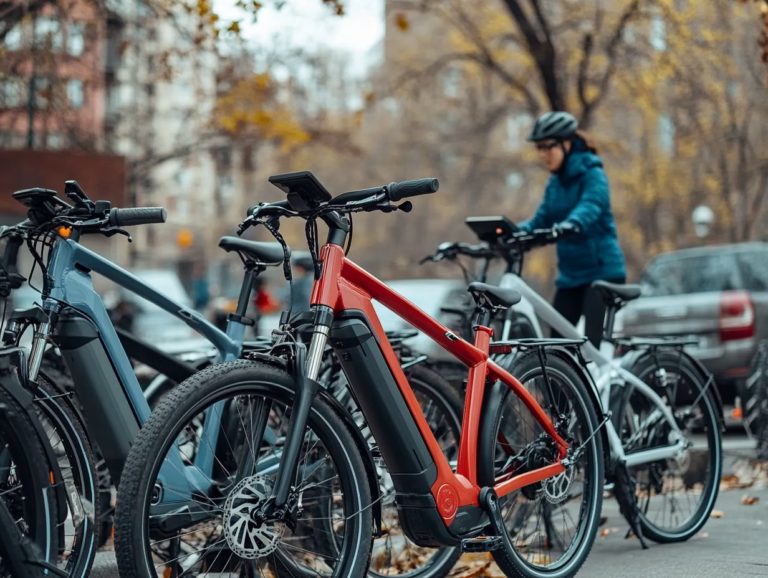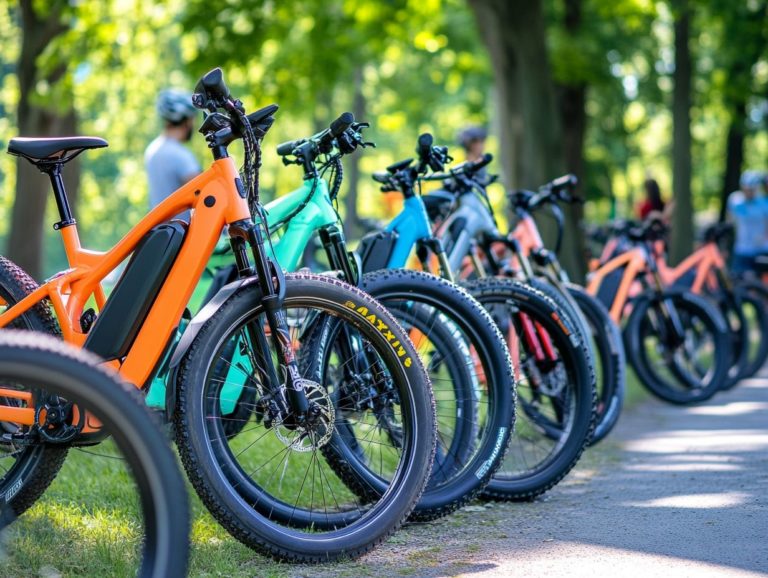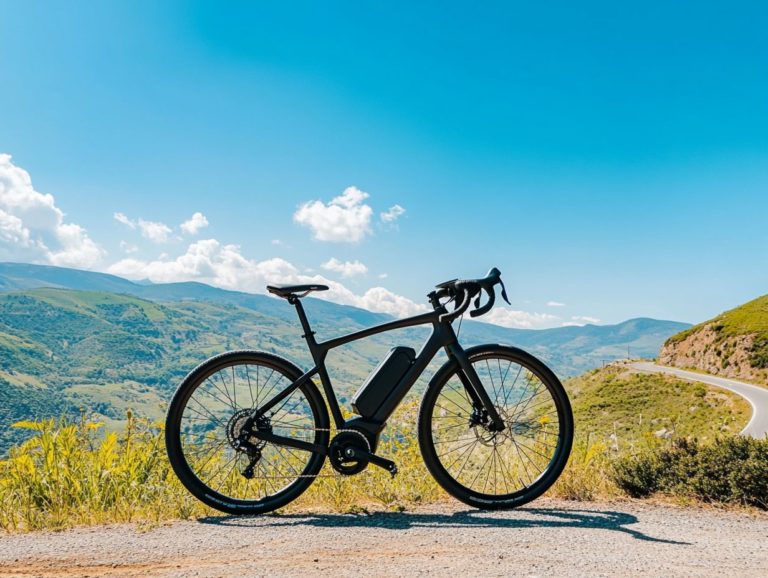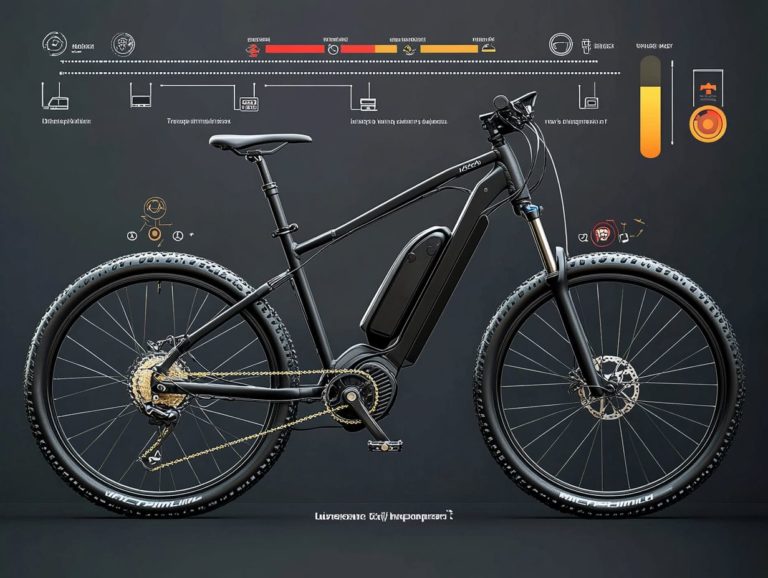How to Identify Quality Electric Bicycle Types
Electric bicycles are revolutionizing the way you commute, offering a delightful mix of convenience, sustainability, and sheer fun.
This guide delves into what defines an electric bicycle, often called an ebike, and highlights the myriad benefits they bring to your daily life. It categorizes the various types of electric bikes, discusses essential factors to consider before making a purchase, and pinpoints key features that signify quality.
You ll also find valuable tips on maintaining your e-bike, ensuring it remains in peak condition for all your adventures. Whether you’re an experienced rider or simply curious about the world of electric biking, there s something here for everyone.
Contents
- Key Takeaways:
- Understanding Electric Bicycles
- Types of Electric Bicycles
- Factors to Consider Before Buying
- Identifying Quality Electric Bicycles
- Maintenance and Care for Electric Bicycles
- Frequently Asked Questions
- What are the key characteristics of a quality electric bicycle?
- How can I determine the battery life of an electric bicycle?
- What should I look for when examining the motor of an electric bicycle?
- What is the ideal weight for a quality electric bicycle?
- How do I know if an electric bicycle is made with high-quality materials?
- Can I test ride an electric bicycle before purchasing?
Key Takeaways:
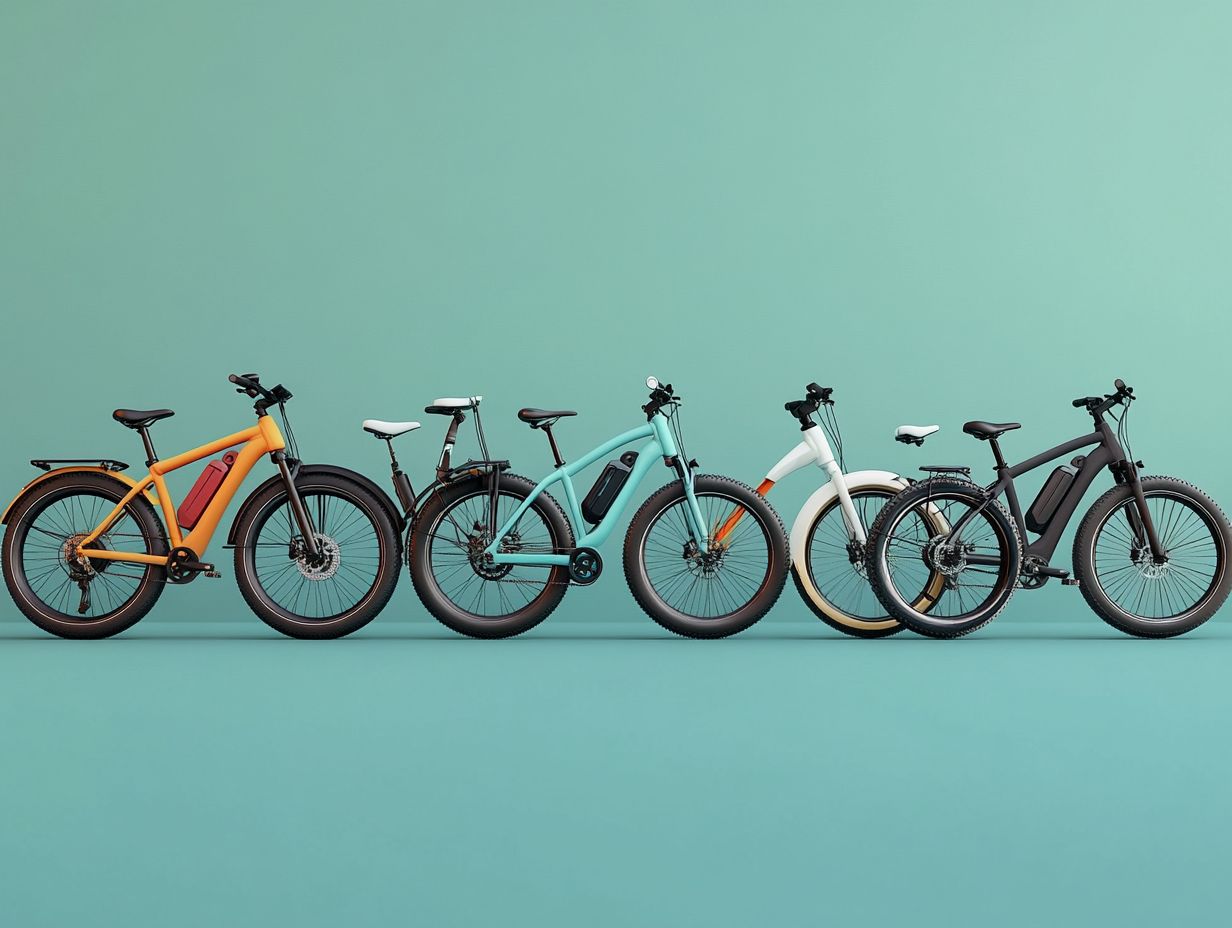
- Electric bicycles provide numerous benefits, including eco-friendliness and versatility in terrain.
- Understanding different types of electric bicycles is essential. It helps you choose the right one for your needs and budget.
- Quality electric bicycles should have key components like a durable frame, reliable motor, and efficient battery, along with features like suspension and multiple riding modes.
Understanding Electric Bicycles
Understanding electric bicycles means exploring the various types available like electric mountain bikes, urban ebikes, and gravel ebikes each crafted to meet specific commuting needs and recreational preferences.
You can choose from two main types of electric bikes! These include pedal assistance and throttle-controlled models. Pedal assistance boosts your pedaling power to help you ride more easily, while throttle-controlled models let you engage the motor with just a twist of the throttle for a breezy ride without any pedaling required. To learn more about these options, check out this beginner’s guide to electric bicycle types.
With technological advancements, electric road bikes and other e-bike models have surged in popularity, thanks to their efficiency, user-friendliness, and ability to conquer diverse terrains. Understanding the 5 key differences between e-bike types showcases this versatility, making them an appealing choice for any rider.
Features like hub motors and mid-drive motors elevate the riding experience. Hub motors are located in the wheels and help propel the bike forward, while mid-drive motors are found near the pedals for better balance and power.
What is an Electric Bicycle?
An electric bicycle, or ebike, is essentially your trusty steed enhanced with an electric motor that lends a helping hand when you pedal. This makes your ride much more enjoyable, especially on hilly routes or longer commutes.
You ll find most electric bicycles in two formats: pedal-assist and throttle-controlled models.
Opting for an ebike for your daily commute comes with a host of benefits, including shortened travel times, reduced physical strain, and a sustainable alternative to gas-guzzling vehicles.
For those who ride for pleasure, the extended range provided by various e-bike models gives you the power to explore more challenging terrains without the lingering worry of fatigue.
Benefits of Owning an Electric Bicycle
Owning an electric bicycle offers amazing benefits! Get ready to transform your commute and leisure rides.
Consider the cost savings; when you weigh electric biking against traditional commuting methods like driving or public transport, the benefits become clear. Your fuel expenses and parking fees will take a nosedive, leaving you with more disposable income to enjoy.
From an environmental perspective, transitioning to an e-bike significantly reduces your carbon footprint, as these energy-efficient machines run on electricity rather than fossil fuels.
If health is a priority for you, cycling promotes cardiovascular fitness and muscle strength, offering an excellent form of exercise without the strain that often comes with traditional biking.
Lastly, the convenience of charging, the charging speed, and a dependable battery range play a crucial role in your daily usage, simplifying the decision to embrace an electric bike, especially when considering the best types of electric bicycles for long rides for your transportation needs.
Types of Electric Bicycles
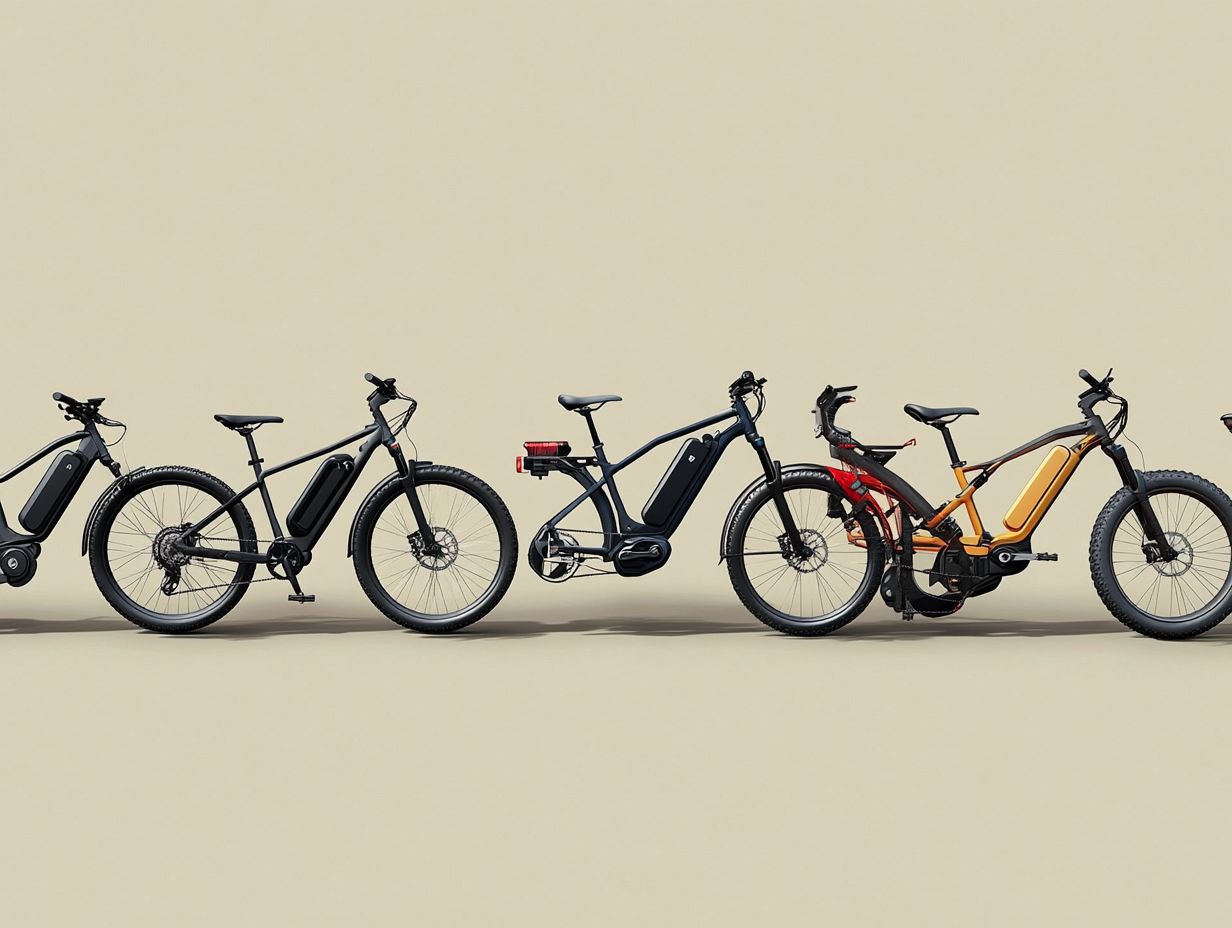
Electric bicycles come in many types. From electric mountain bikes to electric road bikes, each is designed for your riding style and terrain.
You’ll easily find the perfect ebike that suits your needs!
Among these options, electric mountain bikes (eMTB) excel in rugged terrains and trails, boasting robust features and enhanced stability.
If your focus is on city commuting, urban ebikes prioritize comfort and practicality. They come with lightweight frames and efficient battery systems.
For speed enthusiasts, electric road bikes offer an aerodynamic design alongside high performance. Gravel ebikes invite adventurous riders seeking versatility across mixed surfaces.
Classifications and Features
Electric bicycles fall into three main categories: Class 1, Class 2, and Class 3. Each category has unique features and regulations suited to different riding preferences.
Class 1 ebikes provide a pedal-assist feature, which helps you pedal with less effort while the motor supports you up to 20 mph. They are perfect if you prefer a traditional cycling experience with modern convenience.
Class 2 ebikes come with a throttle that lets you ride without pedaling. This is beneficial if you want a more relaxed ride or need extra help due to physical limitations.
Class 3 ebikes take things up a notch, offering pedal assist speeds reaching up to 28 mph. These are ideal for experienced cyclists or commuters looking to cover longer distances quickly.
The distinctions in motor placement and battery capacity across these classes shape your riding experience and affect acceleration, handling, and battery range. Moreover, they dictate compliance with local regulations, which may impose restrictions based on these classifications. Stay aware of your surroundings while enjoying your ride!
Factors to Consider Before Buying
Before investing in an electric bicycle, weigh several critical factors to ensure you choose the perfect model tailored to your needs. Start by defining your budget; this will guide your options.
Next, consider the frame size that will provide optimal comfort and efficiency during your rides. When choosing an electric bike, also look into the best budget electric bicycle types for beginners as quality components are equally important, enhancing both durability and performance across various conditions.
Think quickly about your commuting patterns; this will guide your choice of battery range, ensuring your ebike can handle daily trips without frequent recharging. By thoughtfully considering these elements, you’ll be well-equipped to make a decision that complements your lifestyle effortlessly. Additionally, exploring the various electric bicycle types for recreational riding can help you find the perfect fit for your needs.
Budget, Riding Needs, and Terrain
When selecting an electric bicycle, evaluate your budget, riding preferences, and the types of terrain you plan to tackle. These factors significantly influence your choice of ebike type and specifications.
Understanding the initial investment is vital, but don’t overlook potential savings from reduced fuel costs and maintenance when commuting with an ebike daily.
The features available can vary widely among different models, from battery capacity to motor power. To make the best choice, consider choosing the right electric bicycle type for you and align these attributes with your unique riding habits.
For example, if you frequently encounter hilly terrain, opt for an ebike with a powerful motor and robust gearing. Conversely, if you’re an urban commuter navigating mostly flat roads, a simpler model may suffice. To make an informed decision, consider understanding different types of electric bicycles to ensure both performance and cost-effectiveness align with your long-term needs.
Identifying Quality Electric Bicycles
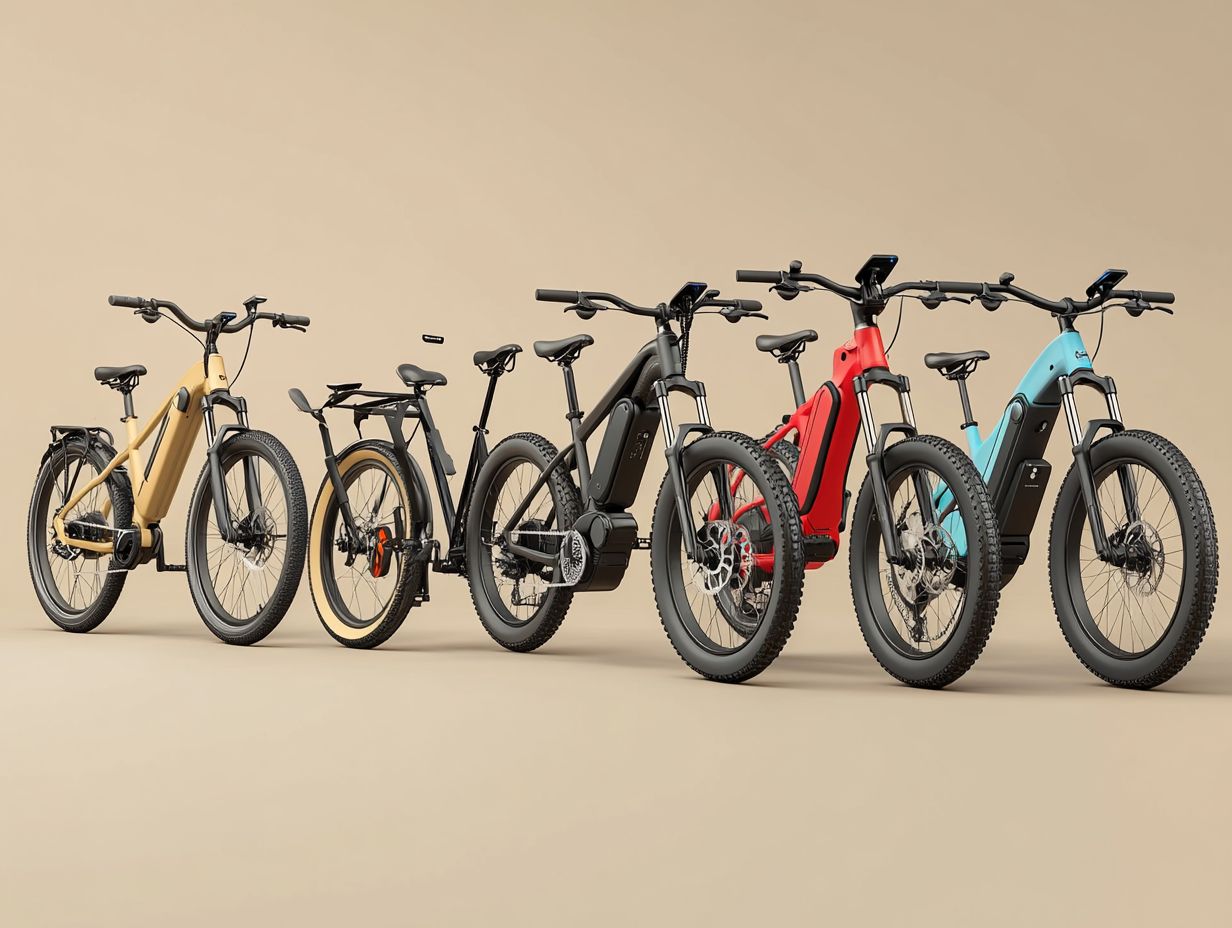
In terms of identifying a quality electric bicycle, you’ll want to assess several key features and components that enhance performance and contribute to the bike’s longevity. This ensures you make a worthwhile investment in an e-bike tailored to your riding needs.
Begin by examining the quality of the components used in the bike s construction. This will significantly impact its durability and performance. Next, consider the battery range, as it determines how far you can travel on a single charge. This is crucial for your riding adventures.
The charging speed is another vital factor that dictates how fast the battery charges, making it convenient for your daily use.
Familiarizing yourself with the various types of e-bikes available will help you choose a model that fits your lifestyle and cycling preferences. For a great starting point, check out the top 5 electric bicycle types for commuters.
Key Components and Features to Look For
When you’re on the hunt for an electric bicycle, it is essential to focus on key components and features that can greatly enhance your riding experience. Consider aspects like battery range, motor placement, and the overall quality of the components in the e-bike models you re evaluating.
The battery is the lifeblood of your electric bicycle. It determines how far you can travel before needing a recharge.
A strong battery not only extends your range but also allows for longer adventures without the nagging worry of running out of juice.
Next, the motor, whether cleverly placed in the hub or mid-drive, plays a crucial role in how power is delivered. Mid-drive motors, like those in the Trek Super Commuter, offer superior weight distribution and climbing capabilities. Hub motors, found in models like the Rad Power Bikes RadRover, provide a simpler setup and require less maintenance. For a deeper understanding, consider comparing different electric bicycle designs.
Frame materials also significantly influence your riding dynamics. Aluminum frames are lightweight and budget-friendly. In contrast, carbon fiber frames, such as those on premium models like the Specialized Turbo Vado, offer exceptional durability and performance, enhancing your comfort and handling during every ride. For those considering an electric bike, understanding the different options is crucial; check out the electric bicycle types comparison chart.
Maintenance and Care for Electric Bicycles
Proper maintenance and care for your electric bicycle are vital for ensuring its longevity and optimal performance. This allows you to capitalize on your investment in a quality ebike.
Your regular maintenance routine should encompass checking the battery health and verifying the proper placement of the motor. Inspect essential components such as brakes and tires, all critical for safe and enjoyable rides.
Moreover, gaining insight into battery care like effective charging practices and storage tips can significantly extend its lifespan and elevate your overall cycling experience.
Tips for Keeping Your Electric Bicycle in Top Condition
To keep your electric bicycle in peak condition, embrace these essential maintenance tips that prioritize battery care, high-quality components, and routine checks for optimal performance and longevity.
Regular upkeep not only extends the lifespan of your ebike but also elevates your overall riding experience. Begin by cleaning the frame and components with a mild detergent and a soft brush this gentle approach helps prevent damage.
Don t forget about the drivetrain; ensure all parts are free from grime and well-lubricated.
Tire maintenance is equally vital. Checking the tire pressure can ward off flats and guarantee a smooth ride. Inspect the brakes for wear and proper alignment to maintain safe stopping power.
Battery health should be at the forefront of your maintenance routine. Charge it according to the manufacturer’s guidelines and store it in a cool, dry place to maximize its durability.
Frequently Asked Questions
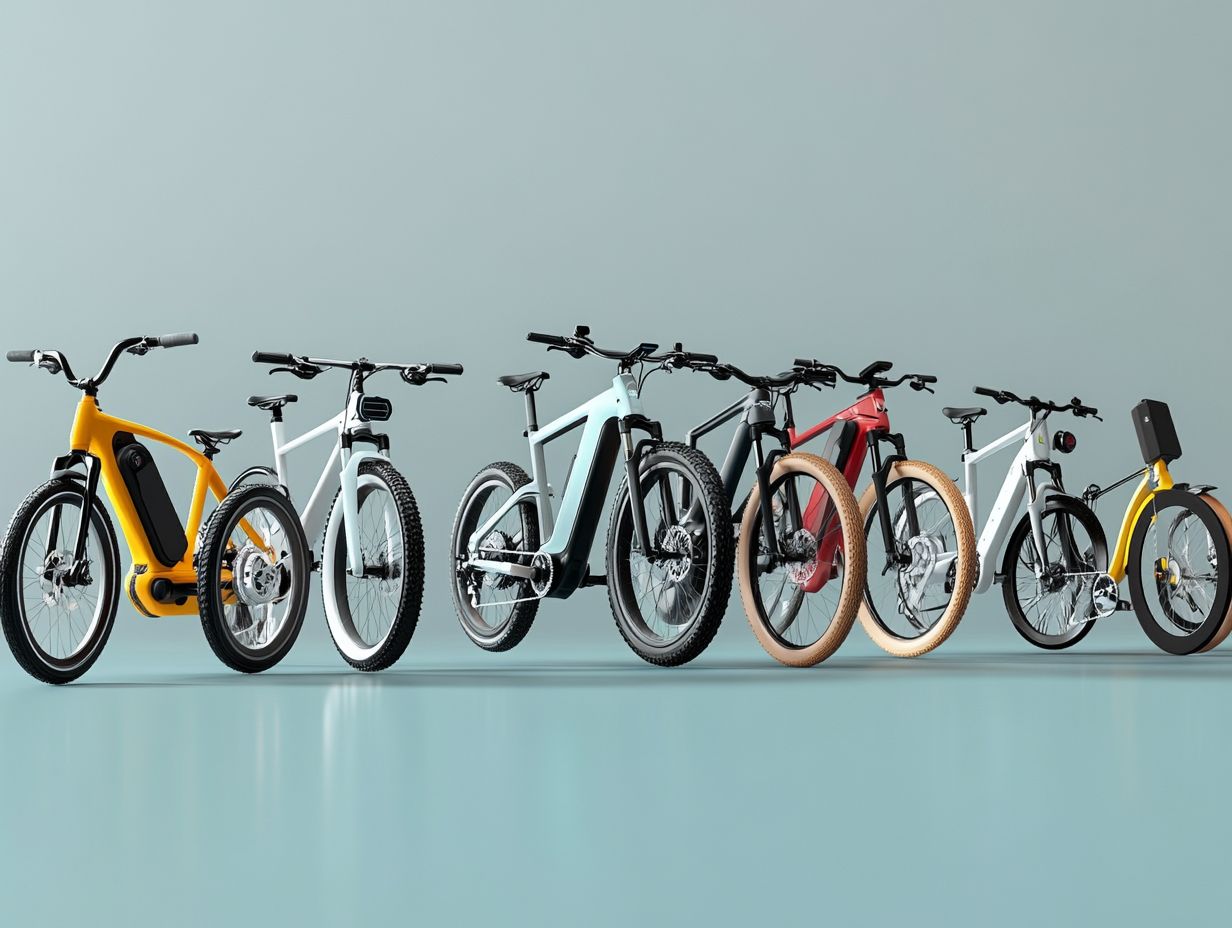
What are the key characteristics of a quality electric bicycle?
A quality electric bicycle should have a sturdy frame, powerful motor, long-lasting battery, reliable brakes, and smooth-shifting gears.
How can I determine the battery life of an electric bicycle?
The battery life is determined by the battery’s voltage and amp hours.
A higher voltage and more amp hours mean a longer-lasting battery.
What should I look for when examining the motor of an electric bicycle?
Look for a motor that doesn t have brushes or gears.
This type of motor is usually more efficient and lasts longer.
What is the ideal weight for a quality electric bicycle?
A quality electric bicycle should weigh between 40-60 pounds.
This weight ensures good stability and maneuverability.
How do I know if an electric bicycle is made with high-quality materials?
Check the frame and parts for rust or signs of wear.
Quality electric bicycles often use materials like aluminum or carbon fiber, which are strong and resistant to rust.
Can I test ride an electric bicycle before purchasing?
It s essential to test ride an electric bicycle before making a purchase!
This will help you understand the bike’s handling and comfort to see if it s right for you.



